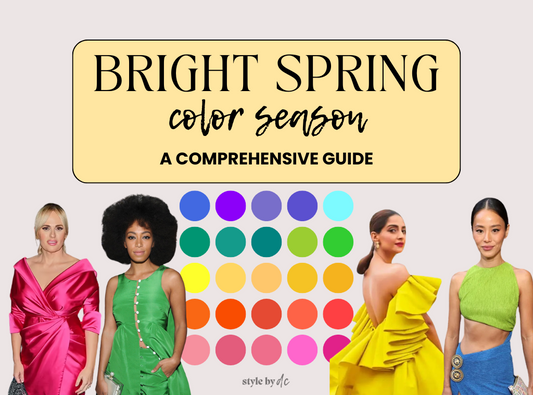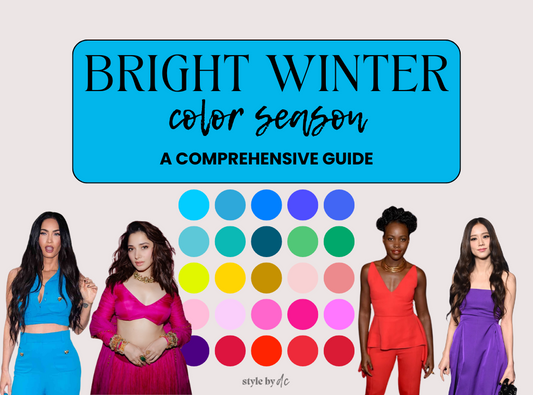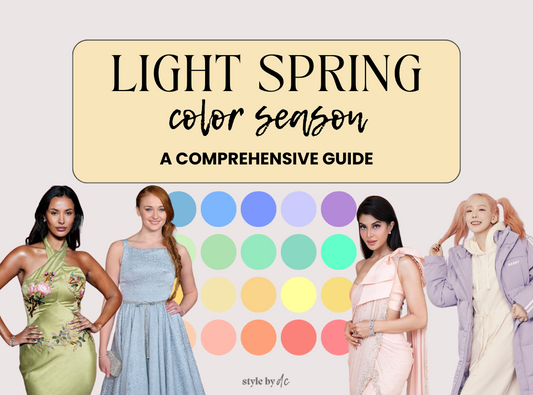If you’ve ever Googled "personal colour analysis near me" or gotten lost in a seasonal color analysis quiz spiral, you’re not alone. The rise in popularity of color analysis—from viral TikToks to Korean color analysis and online tools—has sparked renewed curiosity about the power of finding your "wow" colors.
But here’s the thing: what most people think they want from a color analysis isn’t actually what delivers the transformation they’re looking for. It’s easy to assume that once you get your palette (summer color analysis! autumn color analysis! maybe spring?), you’ll instantly feel more stylish, beautiful, and put-together.
Yet many walk away from their first experience with more confusion, not clarity.
Let’s break down what a personal color analysis can do for you—and where the marketing hype might be missing the point.

What You Don’t Really Want (Even If You Think You Do)
1. A Simple Label ("I’m a Soft Autumn")
Sure, it's satisfying to land on a season after your color analysis like True Winter or Soft Autumn —especially if you've taken every color analysis quiz online. But most people quickly find that a seasonal name alone doesn't translate into real-life shopping or styling decisions.
You’ll notice this when you go to look up specific items to buy like “soft autumn dress”. Most retailers out there don’t classify their clothing by color season, so it can be a bit of a guessing game when ordering online. There are forums for specific color groups that may share an item they found in their season - but this leads to even more limitations to your personal style. Sure, someone else has vetted that this dress is a good Dark Winter color but do you really want to all be wearing the same dress?
Without context, it becomes just another personality test. Fun to know, hard to apply.
2. A Rulebook of What You Can’t Wear
Many people fear (or expect) that color analysis is about restriction: a list of “no-go” colors, harsh judgments, and the dreaded closet purge. But this isn’t helpful, and it's definitely not empowering.
In fact, overly rigid approaches often push people away from their personal style, rather than closer to it. If you’ve ever felt like you “don’t like your season” or found your palette uninspiring, this is likely why. The goal isn’t to box you in. It’s to help you choose color with intention—not obligation.
3. A Fast Fix to Style Confusion
A seasonal color analysis quiz can give you a place to start. But the truth? Knowing your undertone won’t magically solve years of style uncertainty. (And don’t even get me started on the fixation on undertone!)
Real transformation takes a bit of reflection. Color analysis can help guide that process—if it’s done well. If you’re just looking for a shortcut, you may be disappointed. But if you’re looking for clarity, it can be a powerful first step.

What You Do Want (Even If You Don’t Know It Yet)
1. Clarity in a World of Visual Overload
Most of us are overwhelmed. We save outfit photos, try every color analysis quiz photo filter, and still end up unsure about what actually works on us.
A well-executed 16 season color analysis with an analyst that is also a personal stylist cuts through the noise. It gives you a customized visual language—using color analysis drapes and tools—to understand what enhances your features and what clashes with them.
That clarity extends beyond color. Once you understand what supports your natural coloring, you also begin to understand what supports your energy, your personality, and your goals.
2. Confidence to Make (and Keep) Style Decisions
After a personalized color analysis, something shifts. Shopping becomes easier. Makeup makes more sense. You’re not guessing anymore. You know which lipstick works with your overall coloring - not just your undertone. You know which hair color analysis result will brighten your face vs. dull it.
That confidence leads to better purchases and fewer regrets. It also cuts down the decision fatigue so many of us feel around getting dressed. That morning moment of “Ugh, what do I wear?” becomes a lot less loaded.
3. Alignment With Your Real Life (and Style Goals)
A great color analysis doesn’t just hand you a palette. It considers your lifestyle, your job, your vibe. It aligns your seasonal color palette with your goals.
Whether you want a more minimalist wardrobe, a playful and expressive aesthetic, or to feel more polished at work—your color story should support that, not complicate it. Color analysis should help you live your life better—not just look better in photos. The best results come when the insights are rooted in your reality, not just a seasonal color palette.
4. A Collaborative, Reflective Process
The best personal colour analysis near you or online isn't one-sided. It shouldn't be a stylist telling you what looks good and walking away.
When done thoughtfully (especially in a hands-on environment like colour analysis in Toronto or color analysis in Niagara Falls), it should be a conversation. You walk away not just knowing your season, but understanding why it matters and how to use it. Whether you’re doing a color analysis online or in person, make sure that your analyst is open to follow up questions and conversation. That kind of dialogue is what turns curiosity into clarity—and clarity into action.

So, What Makes a Color Analysis Worthwhile?
A truly useful color analysis is:
- Collaborative: You feel part of the process, not a passive subject.
- Personalized: It goes beyond your skin tone. It considers your preferences, lifestyle, and goals.
- Holistic: It doesn’t ignore your hair color analysis or personal style vibe. It ties everything together.
- Empowering: You walk away with clarity and confidence, not a rigid rulebook.
That’s the real value. Not just in being labeled a True Winter or Soft Summer, but in understanding how to express who you are through those insights. Color analysis isn’t about conformity—it’s about coherence. It’s not about looking like everyone in your season. It’s about looking like you, with a glow up.
Why the 16 Season Colour Analysis Model Works Better
The original four-season system (spring, summer, autumn, winter) was a great starting point. And then the expansion to the popular 12 season color analysis system created even more variety and customization. But as you may have noticed if you’ve taken more than one seasonal color analysis quiz, it often falls short. Why?
Because people are complex.
The 16 season colour analysis system adds nuance. It allows for blends, subtle shifts, and individuality. You might be best suited to the Bright Spring palette with some cooler leanings, or suit Soft Autumn but can also wear certain colors from Summer. Remember, you are not a season. There is a season that best suits you and types of colors that best suit you.
The added flexibility means:
- Better fit with your natural coloring
- More room for you in the process
- A wider range of hair color analysis options that actually suit you
The method also helps eliminate some of the self-doubt that comes with conflicting results from free seasonal color analysis quizzes. The deeper framework helps resolve those “I’m not sure” moments into “Now I see it.”
Whether you’re searching for “colour analysis near me”, researching personal colour analysis, or browsing digital tools, look for someone who uses the 16 season method and can explain it in a way that makes sense.
If your results feel confusing or limiting—it’s not you. It’s the method (or how it was delivered).
Choose Color Analysis That Sees the Whole You
I know being given a specific season seems like the easiest solution. But, you don’t just want a season. You want:
- Less second-guessing
- More intention in your closet
- A style that feels effortless and true
When you stop chasing the perfect color analysis quiz and start looking for real insight into who you are and how you want to show up, everything gets easier.
So yes, take the seasonal color analysis quiz. But when you're ready for something deeper, find a color analyst who can meet you there. And when you find a color analyst who takes a collaborative, customized approach, your results become something you actually use—not just something you file away.
Whether you’re searching for a color analysis in Niagara Falls, a color analysis in Toronto or online - know that the right color analyst won’t just give you answers. They’ll help you ask better questions.
And that’s where the real transformation begins.



